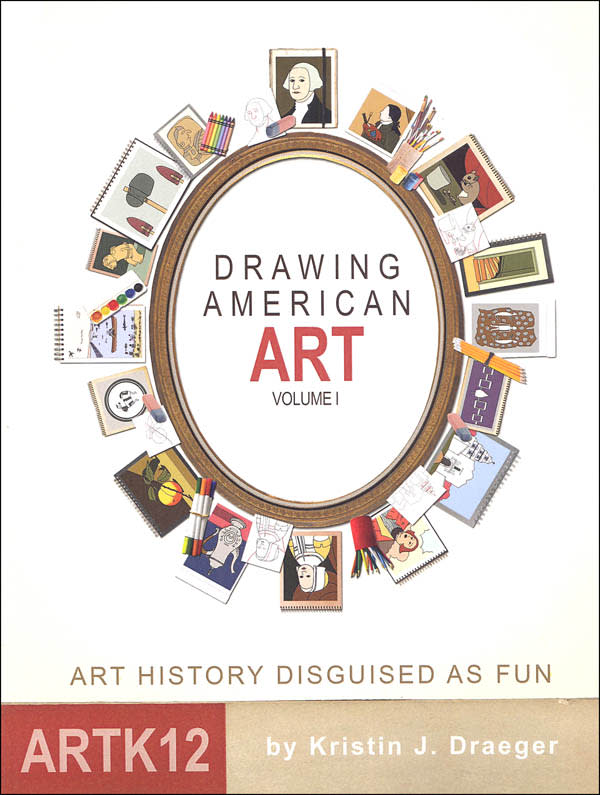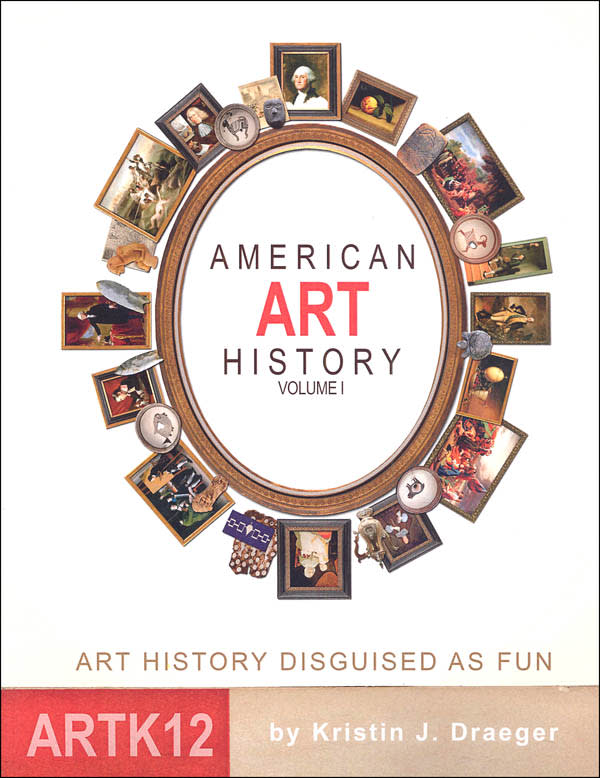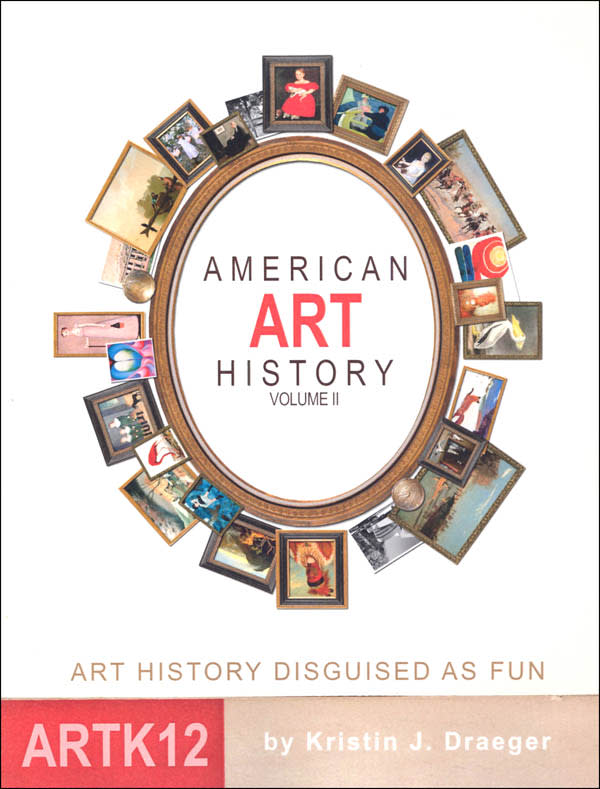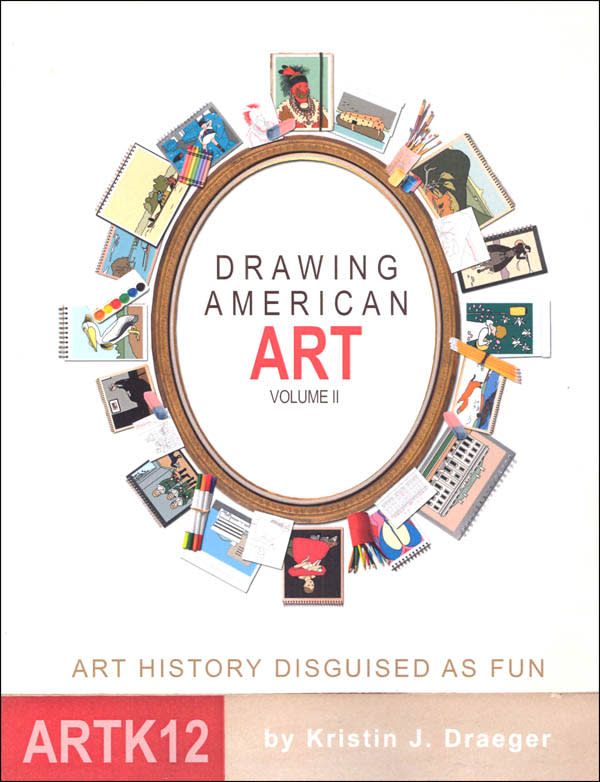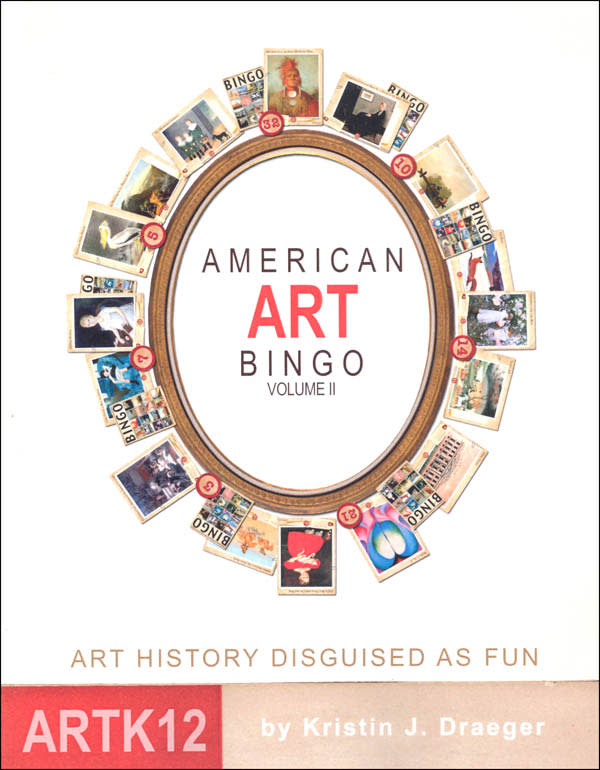American Art History courses present a snapshot approach to art history in two, semester-long courses subtitled Volume I and Volume II. These courses are ideal for grades five through eight, but they might be used with students as young as third grade as well as with high school students.
I received the Volume I course for review, which covers native peoples of the Americas up through the early 1800s. Volume II continues up through the twentieth century. Both courses are laid out in the same fashion with three key components for each course. However, I will describe particulars from only the Volume I course.
American Art History, Volume I works together with Drawing American Art Volume I, and American Art Bingo Volume I to create a one-semester course that covers art history, art appreciation, and drawing. Author Kristin Draeger has selected an interesting mix of sixteen different examples of art or artists to teach about both history and the development of art. Examples of the wide ranging topics in Volume I are:
- Mound Builder art exemplified by a collection of bannerstones and “The Birdman Tablet” made of carved sandstone
- Iroquois art exemplified by wampum belts and wampum strings
- The art of John White exemplified by two of his watercolor paintings, “Indian Village of Pomeiock” and “Indians Fishing”
- Spanish Colonial architecture exemplified by The Alamo and Mission San Diego de Alcala
- The art of Paul Revere exemplified by a silver coffee pot and an engraving with watercolor titled “The Bloody Massacre”
- The art of Gilbert Stuart exemplified by two of his portraits of George Washington, “The Lansdowne Portrait” and “The Athenaeum Portrait”
Topics are presented chronologically so it should be relatively easy to integrate art lessons with your study of history. Of course, that means adjusting the use of the art history lessons to align with your history studies, which means you might not cover the course within one semester, and you will be unlikely to use one lesson per week.
American Art History, Volume I is much more creative than the title indicates. For each of the sixteen topics, Draeger creates fictionalized news reports, interviews, cartoons, advertisements, and other material that is often humorous. For example, bannerstones are introduced with what reads like the script for television or radio commercial:
Having trouble with your spear thrower? Is it awkward and unbalanced? Instead of soaring weightlessly through the air does your spear crash and burn? Does your prey snicker when they see you coming?
If these things happen to you, then you will be delighted with the newest invention to come out of the Mound Association for the Improvement of Missiles (MAIM) They have recently released their Spear Thrower 2.0, a technological advancement of mind-blowing proportions
The revolutionary innovation of the Spear Thrower 2.0 is its bannerstone. A bannerstone is a carved weight that sits on the end of the spear thrower and helps balance it so that catapulting the spear is a breeze. (American Art History, Volume I, p. 22)
Each of the sixteen topics has a number of pages of text with content such as I described above. While some of this might lend itself to being read-aloud, students should be able to read and look at the book themselves so they can read through the cartoons and fake advertisements. Parents might need to explain some of them to younger students.
Within each lesson, one or more “Forgery” games for each topic show an image of the original piece of art, building, or display. Next to it is a “forgery” with ten small details that differ from the original which students need to identify. This focuses students on details in a playful way that they should enjoy.
After reading through the lesson and playing the Forgery Game, you can move onto either the bingo games or the drawing book.
American Art Bingo, Volume I is meant to be cut apart to be used for bingo games. There are 32 full-page image “cards” with the same images that were highlighted in American Art History, Volume I. The image and brief information are included on one side of a page, and on the reverse is the topic under which this artwork falls, its title, the time period when it was created, and the media used. These pages are shuffled and “called” as you play bingo. Ten, double-sided bingo board pages allow up to ten students to play at one time. You should laminate these pages or place them in page protectors since they should get lots of usage. The intent is that you play bingo each week, introducing art works that will be studied in the future along with those already studied. Toward the end of the semester, you should try calling only the name of the artwork without showing the image since students should be familiar with almost all of them by that time.
Drawing American Art, Volume I offers relatively easy drawing and coloring activities with very simplified pictures based upon the featured artworks in American Art History, Volume I. For example, for Spanish Colonial Art students will draw a simplified picture of Mission San Diego de Alcala.
There is one drawing activity to accompany each lesson in American Art History, Volume I. Templates with boxes help keep student drawings to a manageable size. (Templates can be printed from the publisher’s website or photocopied from pages at the back of this book.) Within each template are some key lines, points or shapes to help students get started. Step-by-step illustrations walk students through the drawing process. A colored image then gives students an idea as to how they should color the picture. Crayons, colored pencils, or markers can be used for coloring.
Drawing activities should be doable for most fifth graders, but some of them might be too difficult for younger students. On the other hand, they might be too simplistic for older students who already have experience with drawing. You might challenge experienced students to create their own version of each drawing without a template.
All of the books are printed in full color and are heavily illustrated—very visually appealing. All of the books are reusable—even the bingo game pieces as long as you keep them together. Draeger says that in the classroom she uses one set of the Art History and Drawing books for every two students. This sounds like a practical approach for homeschoolers. Students need to be able to view both books, but they probably don’t need to “own” their own books since they won’t be writing in them. A parent with one child should be able to work from one set of books.
Lessons using all three components might take up to two hours per week in a classroom setting but maybe less than that in a homeschool. While the American Art History book might be used on its own, the other two are dependent upon the first book. So you can spend less time by omitting either bingo games or drawing. Still, it seems best if you can use all three components.
The art history and appreciation taught within this course is selective rather than comprehensive. Realistically, this might still be more than most homeschoolers cover in even the best of situations. The subtitle of this series is “Art History Disguised as Fun,” and this course certainly lives up to that.









